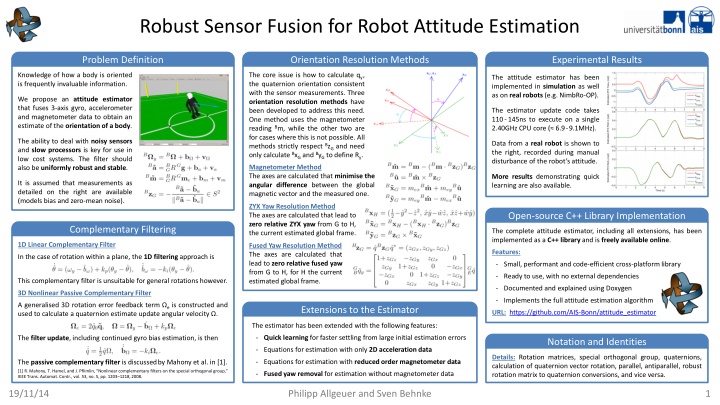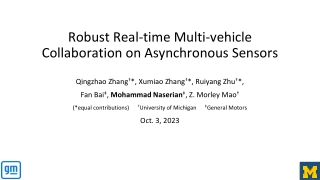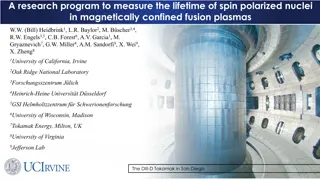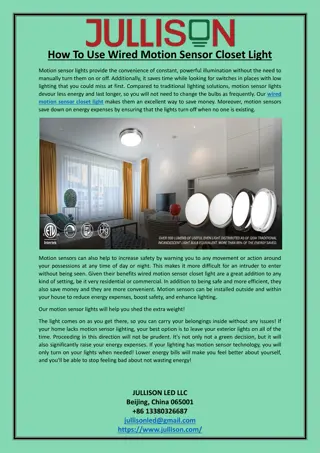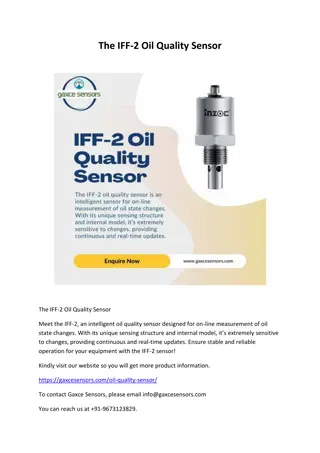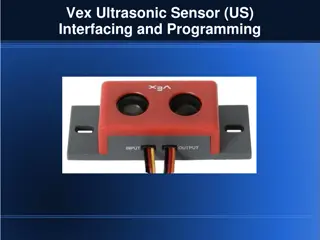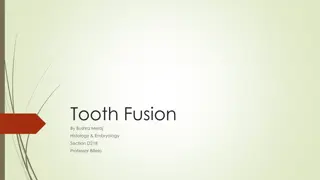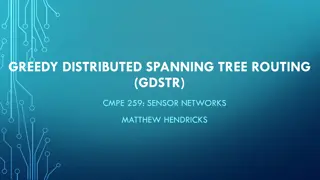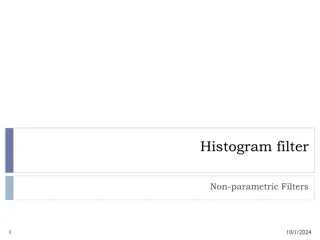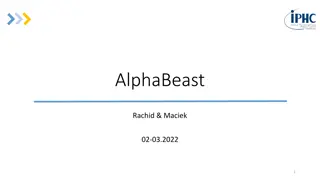Robust Sensor Fusion for Robot Attitude Estimation
Attitude estimation is crucial for robots to understand their orientation relative to the global frame. This project presents an attitude estimator that combines gyro, accelerometer, and magnetometer data to calculate a quaternion orientation estimate. The robust sensor fusion method ensures accurate orientation resolution even in the presence of noise. The estimator is designed to be efficient, stable, and suitable for low-cost systems. With open-source C++ library implementation and extensions like quick learning and fused yaw resolution, this project aims to enhance robot attitude estimation capabilities.
Download Presentation

Please find below an Image/Link to download the presentation.
The content on the website is provided AS IS for your information and personal use only. It may not be sold, licensed, or shared on other websites without obtaining consent from the author.If you encounter any issues during the download, it is possible that the publisher has removed the file from their server.
You are allowed to download the files provided on this website for personal or commercial use, subject to the condition that they are used lawfully. All files are the property of their respective owners.
The content on the website is provided AS IS for your information and personal use only. It may not be sold, licensed, or shared on other websites without obtaining consent from the author.
E N D
Presentation Transcript
Robust Sensor Fusion for Robot Attitude Estimation C:\Users\Phil\Documents\My LaTeX Documents\Attitude Estimation\presentation\images\attitude_estimator_icon_large.png Robust Sensor Fusion for Robot Attitude Estimation Problem Definition Orientation Resolution Methods Experimental Results Problem Definition Orientation Resolution Methods Experimental Results Knowledge of how a body is oriented is frequently invaluable information. The core issue is how to calculate qy, the quaternion orientation consistent with the sensor measurements. Three orientation resolution methods have been developed to address this need. One method uses the magnetometer reading Bm, while the other two are for cases where this is not possible. All methods strictly respect BzG and need only calculate BxG and ByG to define Ry. Magnetometer Method The axes are calculated that minimise the angular difference between the global magnetic vector and the measured one. The attitude estimator has been implemented in simulation as well as on real robots (e.g. NimbRo-OP). We propose an attitude estimator that fuses 3-axis gyro, accelerometer and magnetometer data to obtain an estimate of the orientation of a body. The estimator update code takes 110-145ns to execute on a single 2.40GHz CPU core ( 6.9-9.1MHz). The ability to deal with noisy sensors and slow processors is key for use in low cost systems. The filter should also be uniformly robust and stable. Data from a real robot is shown to the right, recorded during manual disturbance of the robot s attitude. More results demonstrating quick learning are also available. It is assumed that measurements as detailed on the right are available (models bias and zero-mean noise). ZYX Yaw Resolution Method The axes are calculated that lead to zero relative ZYX yaw from G to H, the current estimated global frame. Open-source C++ Library Implementation Open-source C++ Library Implementation Complementary Filtering Complementary Filtering The complete attitude estimator, including all extensions, has been implemented as a C++ library and is freely available online. 1D Linear Complementary Filter Fused Yaw Resolution Method The axes are calculated that lead to zero relative fused yaw from G to H, for H the current estimated global frame. Features: In the case of rotation within a plane, the 1D filtering approach is Small, performant and code-efficient cross-platform library Ready to use, with no external dependencies This complementary filter is unsuitable for general rotations however. Documented and explained using Doxygen 3D Nonlinear Passive Complementary Filter Implements the full attitude estimation algorithm Extensions to the Estimator A generalised 3D rotation error feedback term eis constructed and used to calculate a quaternion estimate update angular velocity . Extensions to the Estimator URL: https://github.com/AIS-Bonn/attitude_estimator The estimator has been extended with the following features: Notation and Identities Quick learning for faster settling from large initial estimation errors The filter update, including continued gyro bias estimation, is then Notation and Identities Equations for estimation with only 2D acceleration data Details: Rotation matrices, special orthogonal group, quaternions, calculation of quaternion vector rotation, parallel, antiparallel, robust rotation matrix to quaternion conversions, and vice versa. Equations for estimation with reduced order magnetometer data The passive complementary filter is discussed by Mahony et al. in [1]. [1] R. Mahony, T. Hamel, and J. Pflimlin, Nonlinear complementary filters on the special orthogonal group, IEEE Trans. Automat. Contr., vol. 53, no. 5, pp. 1203 1218, 2008. Fused yaw removal for estimation without magnetometer data 19/11/14 Philipp Allgeuer and Sven Behnke 1
Robust Sensor Fusion for Robot Attitude Estimation C:\Users\Phil\Documents\My LaTeX Documents\Attitude Estimation\presentation\images\attitude_estimator_icon_large.png Robust Sensor Fusion for Robot Attitude Estimation Problem Definition Problem Overview Attitude estimation is the task of constructing an estimate of the full 3D orientation of a body relative to some global fixed frame, based on a finite history of sensor measurements. Knowledge of how a body is oriented relative to the world is frequently invaluable information for the purposes of localisation and/or control. We propose an attitude estimator that fuses 3-axis gyroscope, accelerometer and magnetometer data into a quaternion orientation estimate. The estimator should be able to function well with low cost hardware. This means that the estimator must be computationally efficient (slow processor), and be able to cope with high noise inputs without excessively sacrificing estimator response. The estimator should also be uniformly robust and stable. Gyroscope Measurements This sensor is assumed to measure the angular velocity of the body, in body- fixed coordinates. The measurement is assumed to be affected by a gyroscope bias b , and zero-mean sensor noise v . That is, Accelerometer Measurements This sensor is assumed to provide a measure of the proper acceleration of the body. This corresponds to the combination of inertial acceleration and gravity, where the latter component is assumed to dominate. The measurement is assumed to be affected by a time-invariant bias ba, and zero-mean sensor noise va. An accelerometer calibration should be used to estimate BzG. That is, Magnetometer Measurements This sensor is assumed to provide a measure of the strength and direction of the Earth s magnetic field, in body-fixed coordinates. The measurement is assumed to be affected by a time-invariant bias bm, and zero-mean sensor noise vm. A hard-iron magnetometer calibration is assumed. That is, 19/11/14 Philipp Allgeuer and Sven Behnke 2
Robust Sensor Fusion for Robot Attitude Estimation C:\Users\Phil\Documents\My LaTeX Documents\Attitude Estimation\presentation\images\attitude_estimator_icon_large.png Robust Sensor Fusion for Robot Attitude Estimation Complementary Filtering 1D Linear Complementary Filter For simple 1D rotations within a plane, a complementary filter can be constructed that fuses the low pass attitude information from the accelerometer with the high pass attitude rate data from the gyroscope. This is achieved by integrating the angular velocity data and feeding the angle information back via a proportional-integral (PI) controller. The filter equations are given by 3D Nonlinear Passive Complementary Filter Let {B} be the body-fixed frame, {G} be the global frame, and {E} be the estimated body-fixed frame relative to the global frame {G}, based on the current quaternion orientation estimate. Based on the accelerometer and magnetometer measurements, we first construct a measured orientation qy. This is the purpose of the orientation resolution methods. The estimated rotation error can then be calculated, and the axis of this is used for the corrective error feedback term e. That is, y g The calculated update angular velocity is applied to the current quaternion orientation estimate, and the gyroscope bias estimate is updated based on the corrective error feedback term e. That is, The 1D filter may na vely be implemented independently in two of three axes in the general 3D case, but this generally gives unsatisfactory results and fails to capture much of the dynamics of 3D rotations. Extension of Complementary Filtering to 3D It is desired to formulate a complementary filter on the full 3D rotation space that retains the positive frequency characteristics of the 1D filter. Mahony et al. published the passive complementary filter in [1]. The similarity of the passive complementary filter to the 1D filter presented on the left should become apparent when contrasting the filter equations. [1] R. Mahony, T. Hamel, and J. Pflimlin, Nonlinear complementary filters on the special orthogonal group, IEEE Trans. Automat. Contr., vol. 53, no. 5, pp. 1203 1218, 2008. 19/11/14 Philipp Allgeuer and Sven Behnke 3
Robust Sensor Fusion for Robot Attitude Estimation C:\Users\Phil\Documents\My LaTeX Documents\Attitude Estimation\presentation\images\attitude_estimator_icon_large.png Robust Sensor Fusion for Robot Attitude Estimation Orientation Resolution Methods Overview The complementary filter requires in each cycle the calculation of a measured quaternion orientation qy best fitting the sensor measurements BzG and Bm. In general these two measurements suffice to construct a unique qy, but if not, the current orientation estimate is also taken as an input. In the following two methods it suffices to calculate the directions of BxG and ByG, after which qy can be calculated by converting the rotation matrix Ry into a quaternion as shown here, where Ry is constructed as ZYX Yaw Resolution Method Let {H} be the current estimated global coordinate frame, relative to {B}. This method seeks to find qy such that the ZYX yaw of {H} with respect to {G} is zero. This ensures that the filter update only minimally affects the yaw. Thus, In the rare case where this method fails, the ZXY yaw is zeroed instead, using Magnetometer Method This method utilises the magnetometer measurement and seeks to minimise the angular difference between the expected global magnetic field vector Gme and Bm by modifying qy (i.e. modifying frame {B}). This condition is seen to be satisfied when the projections of the two vectors onto the xGyG plane are parallel. Denoting Gme = (mex,mey,mez), this leads to Fused Yaw Resolution Method This method seeks to find qy such that the fused yaw of {H}, defined as before, with respect to {G} is zero. This has a convenient quaternion solution, namely This method fails only in boundary cases of the error quaternion, where the filter is insensitive. If this fails, Bm is discarded and one of the yaw resolution methods is used. 19/11/14 Philipp Allgeuer and Sven Behnke 4
Robust Sensor Fusion for Robot Attitude Estimation C:\Users\Phil\Documents\My LaTeX Documents\Attitude Estimation\presentation\images\attitude_estimator_icon_large.png Robust Sensor Fusion for Robot Attitude Estimation Extensions to the Estimator Quick Learning It is desired for the attitude estimate to settle quickly from large estimation errors, yet simultaneously provide adequate general noise rejection. Quick learning allows for two sets of PI gains to be tuned one set that provides suitably fast transient response (quick), and one set that provides good tracking and noise rejection (nom). A parameter on the unit interval is used to fade linearly between the two sets of gains over a given quick learning time, ending in the nominal tracking gains. The gain fading scheme is given by Estimation with Reduced Magnetometer Data If only two-axis X-Y magnetometer data is available, then this can still be used for Bm if the third unknown component is left to zero. This generally still produces satisfactory results due to the projection operation at the beginning of the magnetometer resolution method. If magnetometer data is only available in terms of a relative heading angle , then the required three-axis data can be constructed using Estimation without Magnetometer Data If no magnetometer data is available, then the attitude estimation is entirely reliant on the selected yaw-based orientation resolution method. This still leads to quality estimation results in the pitch and roll dimensions by setting Bm to zero and removing the fused yaw of the output quaternion using The effect of quick learning can be seen in the Experimental Results section. Estimation with Two-Axis Acceleration Data If only two-axis X-Y accelerometer data is available, then the missing part of the acceleration vector can be synthesised by assuming that the norm of the measured acceleration should be the magnitude of gravity, g. In mathematical form this is It is not recommended to remove the Euler ZYX yaw instead, as this leads to unexpected behaviour near the not uncommon case of 90 pitch rotations. Note that the open-loop yaw produced by the estimator remains stable with each update of qy due to the yaw-zeroing approach used. Small drift velocities in the yaw can still unavoidably result however, due to the gyroscope biases. This equation only allows for estimates in the positive z-hemisphere as the sign of the missing az component has to be assumed. For many applications, such as bipedal walking, this can be sufficient. 19/11/14 Philipp Allgeuer and Sven Behnke 5
Robust Sensor Fusion for Robot Attitude Estimation C:\Users\Phil\Documents\My LaTeX Documents\Attitude Estimation\presentation\images\attitude_estimator_icon_large.png Robust Sensor Fusion for Robot Attitude Estimation Experimental Results Figure 1: Estimation results on the NimbRo-OP robot using the magnetometer, ZYX yaw and fused raw orientation resolution methods. The attitude of the robot was manually disturbed for a number of seconds. Figure 2: Simulated attitude estimation results demonstrating the effect of quick learning (with a quick learning time of 3.0s) on the filter s transient response. The simulated estimator was subjected to a step in orientation. 19/11/14 Philipp Allgeuer and Sven Behnke 6
Robust Sensor Fusion for Robot Attitude Estimation C:\Users\Phil\Documents\My LaTeX Documents\Attitude Estimation\presentation\images\attitude_estimator_icon_large.png Robust Sensor Fusion for Robot Attitude Estimation Open-source C++ Library Implementation Attitude Estimator A C++ implementation of a nonlinear 3D IMU fusion algorithm https://github.com/AIS-Bonn/attitude_estimator Attitude Estimator is a generic platform-independent C++ library that implements an IMU sensor fusion algorithm. Up to 3-axis gyroscope, accelerometer and magnetometer data can be processed into a full 3D quaternion orientation estimate, with the use of a nonlinear Passive Complementary Filter. The library is targeted at robotic applications, but is by no means limited to this. Features of the estimator include gyro bias estimation, transient quick learning, multiple estimation algorithms, tuneable estimator parameters, and near- global stability backed by theoretical analysis. Great emphasis has been placed on having a very efficient, yet totally numerically and algorithmically robust implementation of the filter. The code size has also been kept to a minimum, and has been extremely well- commented. The programmatic interface has also been made as easy as possible. Please refer to the extensive documentation of the library for more information on its capabilities and usage caveats. 19/11/14 Philipp Allgeuer and Sven Behnke 7
Robust Sensor Fusion for Robot Attitude Estimation C:\Users\Phil\Documents\My LaTeX Documents\Attitude Estimation\presentation\images\attitude_estimator_icon_large.png Robust Sensor Fusion for Robot Attitude Estimation Notation and Identities Definition: 2-Sphere The 2-sphere S2 is the set of all unit vectors in 3, that is, Identity: Conversions between quaternions and rotation matrices Given a quaternion q = (w, x, y, z), the equivalent rotation matrix is given by Definition: Rotation matrices A rotation matrix is a 3x3 orthogonal matrix with determinant +1 that can be used to represent a rotation. The set of all rotation matrices is the special orthogonal group SO(3), and is given by Given a rotation matrix R, the equivalent quaternion is given by For a rotation from coordinate frame {A} to frame {B}, we have that where for example AyB is the column vector corresponding to the y-axis of frame {B}, expressed in the coordinates of frame {A}. Definition: Quaternions The set of all quaternions , and the subset of pure rotations, are given by Rotation of a vector by a quaternion is most efficiently computed as Definition: Parallel and antiparallel Two linearly dependent vectors are parallel if they are a positive multiple of each other, and antiparallel if they are a negative multiple of each other. 19/11/14 Philipp Allgeuer and Sven Behnke 8
